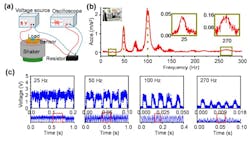Better Predictive Maintenance Through Vibration and Thermal Sensing
What is predictive maintenance (PdM)? It’s the application of instrumentation and intelligence to help determine the condition of equipment and whether maintenance should be performed to avoid downtime.
Predictive maintenance differs from preventive maintenance because it usually applies machine learning to understand current conditions and extrapolate, with increasing accuracy, when maintenance will be needed to avoid downtime. A computerized maintenance management system (CMMS), typically in the form of a software package, is often employed as part of a predictive program or incorporated into predictive-maintenance machine learning.
The demand for better predictive maintenance is on the rise. Having recognized its potential to reduce downtime and increase productivity, predictive maintenance has now become an important competitive factor for many industries and organizations. And, predictive maintenance is becoming more granular, no longer reserved just for the most capital-intensive asset but applied more widely.
Vibration sensing has proven to be one of the most valuable subjects for predictive maintenance attention. Numerous options can serve the purpose, including sensors based on variable capacitance and piezoelectric sensors, further assisted by thermographic and other technologies.
Predictive Maintenance and Variable-Capacitance Sensors
Variable-capacitance sensors can be useful for measuring low frequency vibration. They operate using the concept of differential capacitance, harnessed to detect acceleration or force where capacitance change is proportional to the acceleration or force being measured.
>>Download the PDF of this article
Variable-capacitance accelerometers will deliver stable and accurate measurement, including the measurement of low-frequency vibration. They can also operate over a wide range of temperatures.
Such accelerometers are often built as microelectromechanical systems (MEMS) and are widely used for structural monitoring and constant acceleration measurements. They have a wide range of applications, measuring acceleration, deceleration, or force, making them good monitors of many kinds of mechanical devices and activities.
Predictive Maintenance and Piezoelectric Devices
Rugged and reliable piezoelectric (PE) devices have been a mainstay of vibration monitoring for a long time. Piezoelectric crystals, typically made from lead zirconate titanate, generate power, simplifying their employment in many use cases. They’re tolerant of a wide temperature range and operate at up to approximately 20 kHz.
Flexure-, compression-, and shear-type piezo accelerometers (relative to the structure of the piezo material) each have characteristics that make them more or less appropriate for different tasks.
Temperature sensing has an obvious role, but it may be subject to considerable variation depending on changing ambient conditions or shifts in operating conditions (e.g., processing different types of materials that may consume different amounts of power).
In addition to discrete temperature sensors, infrared thermography may present an opportunity to quickly build knowledge of a system or machine and its operational characteristics as well as potential trouble spots. For instance, multiple heat sources in close proximity and inadequate or failing ventilation could be easily identified with thermal imaging.
This information could be maintained as a map, and changes in that map can be monitored over time and correlated to failure points.
Electronic Analysis to Illuminate Vibration Monitoring
Monitoring power circuits, especially those involved with operating electrical motors, solenoids, etc., can reveal much about the health of the equipment. This can also deliver helpful time-series data of value in preventive maintenance and it’s relevant to understanding the source and cause of vibration issues in combination with other data sources.
To achieve success with vibration monitoring, fidelity and frequency response are vital. Simply recognizing the presence of vibration is of limited value unless that vibration can be analyzed and traced to a source. A key factor is employing sensors that can accurately detect and characterize vibration across a wide range of frequencies to identify all of the contributing factors (see figure).
For example, as a rule of thumb, some sources suggest that for monitoring bearing health, an accelerometer should be sensitive to frequencies of about 50X the shaft RPM. So, for example, an AC electric motor with a nominal 1,725-RPM operating speed would best be paired with an accelerometer that can monitor vibration of around 86 kHz.
Closely related to vibration analysis is a broader look at acoustic information. Almost anything involving moving parts or moving fluids produces sound, some of it audible to humans and some only to appropriate detectors. Subtle signs of friction, wear, slippage, leakage, and breakage are hiding in the sounds made by a machine or process. All of it can best be analyzed with electronics as well as software and analysis tools. This is the key to turning what’s often a large amount of raw data, the storage of which can quickly grow unwieldy, into useful information.
Having sensors that are able to operate over a sound volume range appropriate to the device being monitored is another critical consideration. And, since sound recording can rapidly eat up storage, digitization and/or compression as quickly as possible is desirable. Digital MEMS microphones accomplish analog-to-digital conversion directly, which may be helpful in some applications since this reduces the processing requirements elsewhere.
In any case, longitudinal data from vibration sensors can help produce a record of norms and connect aberrant sounds to actual failures, allowing for improved prediction over time.
Aside from the immediate performance and cost aspects of each instrumentation choice for vibration monitoring and assessment, additional characteristics need to be weighed. These include environmental factors such as temperature tolerance, the extent to which sensor accuracy could drift or degrade over time, and the dynamic range required to provide useful preventive data.
References
Elevating Predictive Maintenance with Advanced Vibration Sensors
>>Download the PDF of this article
About the Author



